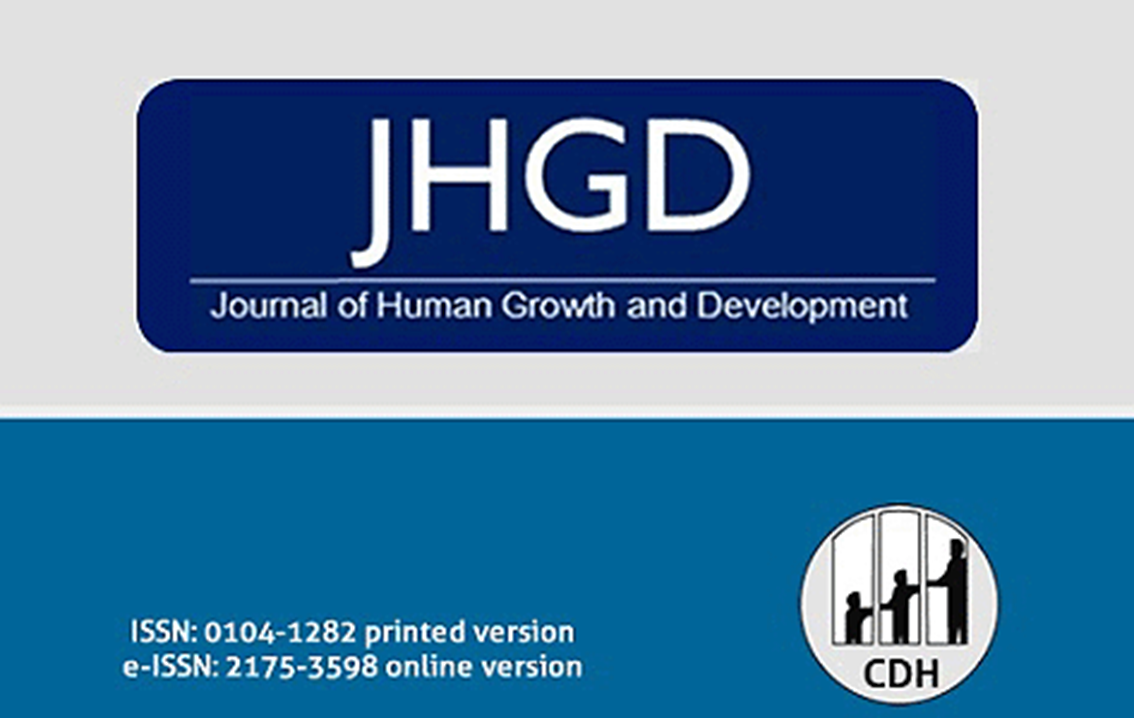Cardiac autonomic modulation in juvenile idiopathic arthritis with use of biological medication: case report
DOI:
https://doi.org/10.7322/jhgd.v30.9962Keywords:
Juvenile arthritis, Inflammation, Etanercept, Autonomic Nervous System, Heart rate variabilityAbstract
Introduction: The introduction of biological medication in Juvenile Idiopathic Arthritis (JIA) proposes better therapeutic results with decreased pain and inflammation and consequent reduction in joint damage. The autonomic state can be a predictor for verifying the response to immunomodulation therapy. Thus, measuring heart rate variability can express autonomous behavior and possibly accompany the response to therapy through the expression of the inflammatory condition.
Objective: Analysis of heart rate variability in a child with Juvenile Idiopathic Arthritis using the anti-Tumor Necrosis Factor.
Methods: This is a clinical case report of an 8-year-old male with a diagnosis of JIA - oligoarticular form, using etanercept, admitted to Clínica Escola de Fisioterapia UNINORTE, Acre, Brazil in 2017. We analyzed laboratory and imaging tests, kinetic-functional evaluation, examination of cardiac autonomic modulation and physiotherapeutic treatment for analgesic, anti-inflammatory purposes, gaining flexibility, strength and postural re-education, according to CARE guidelines, case report guidelines.
Results: After medication administration, there was a decrease in pain and normalization of serum creatinine (0.50 mg / dL) and CRP (less than 6 mg / dL) and an increase in erythrocyte sedimentation rate (17 mm3). In the examination of heart rate variability, the linear indices in the time domain showed a predominance of parasympathetic activity (RMSSD: 35ms), with decreased sympathetic control measured through the frequency domain (LF: 27.1 un). However, non-linear methods showed low variability with little dispersion of RR intervals.
Conclusion: In the present report, the linear indices showed parasympathetic predominance and in the non-linear analysis a low heart rate variability with abnormal and insufficient adaptation of the autonomic nervous system in a child with juvenile idiopathic arthritis using biological medication.
Downloads
References
2. Huang JL. New advances in juvenile idiopathic arthritis. Chang Gung Med J. 2012;35(1):1-14. DOI: http://dx.doi.org/10.1136/adc.2009.170860
3. Rigante D, Bosco A, Esposito S. The Etiology of Juvenile Idiopathic Arthritis. Clin Rev Allergy Immunol. 2015;49(2):253-61. DOI: https://dx.doi.org/10.1007/s12016-014-8460-9
4. Holman AJ, Ng E. Heart rate variability predicts anti-tumor necrosis factor therapy response for inflammatory arthritis. Auton Neurosci. 2008;143(1-2):58-67. DOI: https://doi.org/10.1016/j.autneu.2008.05.005
5. Mota LMH, Cruz BA, Brenol CV, Polak PF, Pinheiro GRC, Laurindo IMM, et al. Segurança do uso de terapias biológicas para o tratamento de artrite reumatoide e espondiloartrites. Rev Bras Reumatol. 2015; 55(3):281-309. DOI: http://dx.doi.org/10.1016/j.rbr.2014.06.006
6. Malave HA, Taylor AA, Nattama J, Deswal A, Mann DL. Circulating levels of tumor necrosis factor correlate with indexes of depressed heart rate variability: a study in patients with mild-to-moderate heart failure. Chest. 2003;123(3):716-24. DOI: https://doi.org/10.1378/chest.123.3.716
7. Abreu LC. Variabilidade da frequência cardíaca como marcador funcional do desenvolvimento. J Hum Growth Dev. 2012;22(3):279-82. DOI: http://dx.doi.org/10.7322/jhgd.46712
8. Straub RH, Bijlsma JW, Masi A, Cutolo M. Role of neuroendocrine and neuroimmune mechanisms in chronic inflammatory rheumatic diseases--the 10-year update. Semin Arthritis Rheum. 2013;43(3):392-404. DOI: https://doi.org/10.1016/j.semarthrit.2013.04.008
9. Raimundo RD, Abreu LC, Adami F, Vanderlei FM, Carvalho TD, Moreno IL, et al. Heart rate variability in stroke patients submitted to an acute bout of aerobic exercise. Transl Stroke Res. 2013;4(5):488-99. DOI: https://doi.org/10.1007/s12975-013-0263-4
10. Adlan AM, van Zanten JJCSV, Lip GYH, Paton JFR, Kitas GD, Fisher JP. Cardiovascular autonomic regulation, inflammation and pain in rheumatoid arthritis. Auton Neurosci. 2017;208:137-45. DOI: https://doi.org/10.1016/j.autneu.2017.09.003
11. Tumiati B, Perazzoli F, Negro A, Pantaleoni M, Regolisti G. Heart rate variability in patients with Sjögren's syndrome. Clin Rheumatol. 2000;19(6):477-80. DOI: https://doi.org/10.1007/PL00011180
12. Boettger MK, Weber K, Grossmann D, Gajda M, Bauer R, Bär KJ, et al. Spinal tumor necrosis factor alpha neutralization reduces peripheral inflammation and hyperalgesia and suppresses autonomic responses in experimental arthritis: a role for spinal tumor necrosis factor alpha during induction and maintenance of peripheral inflammation. Arthritis Rheum. 2010;62(5):1308-18. DOI: https://doi.org/10.1002/art.27380
13. Potenza C, Raimondi G, Pampena R, Proietti I, Viola G, Bernardini N, et al. Cardiovascular risk evaluation through heart rate variability analysis in psoriatic patients before and after 24 weeks of etanercept therapy: Prospective study. J Int Med Res. 2016; 44(1 suppl):43-7. DOI: https://doi.org/10.1177/0300060515593242
14. Davies R, Gaynor D, Hyrich KL, Pain CE. Efficacy of biologic therapy across individual juvenile idiopathic arthritis subtypes: A systematic review. Semin Arthritis Rheum. 2017;46(5):584-93. DOI: https://doi.org/10.1016/j.semarthrit.2016.10.008
15. Ricci-Vitor AL, Rossi FE, Hirai PMH, Silva NT, Vanderlei FM, Haddad MI, et al. Effects of a multidisciplinary program on autonomic modulation in overweight or obese children and adolescents. J Hum Growth Dev. 2016;26(1): 154-61. DOI: http://dx.doi.org/10.7322/jhgd.119257
16. Alves SAA, Oliveira MLB. Sociocultural aspects of health and disease and their pragmatic impact. J Hum Growth Dev. 2018;28(2):183-8. DOI: http://dx.doi.org/10.7322/jhgd.147236
17. Lanza GA, Sgueglia GA, Cianflone D, Rebuzzi AG, Angeloni G, Sestito A, et al. Relation of heart rate variability to serum levels of C-reactive protein in patients with unstable angina pectoris. Am J Cardiol. 2006;97(12):1702-6. https://doi.org/10.1016/j.amjcard.2006.01.029
18. Abreu LC, Pereira VX, Silva RPM, Macedo Jr H, Bezerra IMP. The right to scientific information: one of the main elements of the unified health system. J Hum Growth Dev. 2017;27(3):258-261. DOI: http://dx.doi.org/10.7322/jhgd.141485






